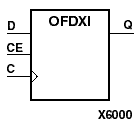Libraries GuideChapter 8: Design Elements (OAND2 to OXOR2)
OFDXI
Output D Flip-Flop with Clock Enable (Asynchronous Preset)
XC3000
| XC4000E
| XC4000X
| XC5200
| XC9000
| Spartan
| SpartanXL
| Spartan2
| Virtex
|
|---|
N/A
| Primitive
| Primitive
| N/A
| N/A
| Primitive
| Primitive
| Macro
| Macro
|

OFDXI is contained in an input/output block (IOB). The output (Q) of the D flip-flop is connected to an OPAD or an IOPAD. The data on the D input is loaded into the flip-flop during the Low-to-High clock (C) transition and appears at the output (Q). When CE is Low, the output does not change.
The flip-flop is asynchronously preset with High output when power is applied. FPGAs simulate power-on when global set/reset (GSR) is active. GSR defaults to active-High but can be inverted by adding an inverter in front of the GSR input of the STARTUP, STARTUP_SPARTAN2, or STARTUP_VIRTEX symbol.
Inputs
| Outputs
|
|---|
CE
| D
| C
| Q
|
|---|
1
| D
| 
| d
|
0
| X
| X
| No Chg
|
d = state of referenced input one setup time prior to active clock transition
|
